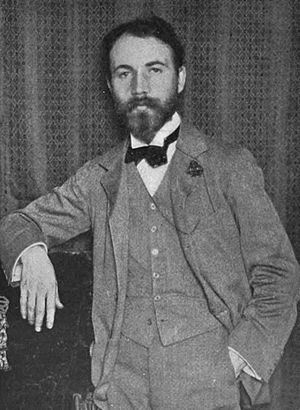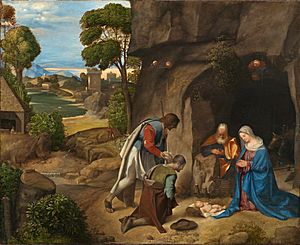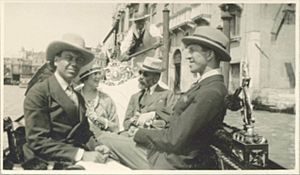Bernard Berenson facts for kids
Quick facts for kids
Bernard Berenson
|
|
|---|---|
 |
|
| Born |
Bernhard Valvrojenski
June 26, 1865 Butrimonys, Vilna Governorate, Russian Empire
|
| Died | October 6, 1959 (aged 94) |
| Nationality | American |
| Occupation | Art historian |
| Known for | The Drawings of the Florentine Painters |
| Spouse(s) | Mary Berenson |
| Relatives | Senda Berenson Abbott (sister) |
Bernard Berenson (born June 26, 1865 – died October 6, 1959) was an American art historian. He was an expert on Renaissance art. His book The Drawings of the Florentine Painters was very popular around the world. His wife, Mary Berenson, also helped with some of his writings.
Berenson was very important in figuring out who painted old artworks. This was a time when American collectors were very interested in these old paintings. People in the art world respected his opinions a lot.
Contents
Bernard Berenson's Early Life
Bernard Berenson was born Bernhard Valvrojenski in Butrimonys, which is now in Lithuania. His family was Litvak, a group of Jewish people from Lithuania. His father, Albert, wanted to become a rabbi. But he later joined a movement called Haskalah. This movement encouraged Jewish people to join regular society more.
In 1875, his family moved to Boston, Massachusetts, in the United States. There, they changed their last name to "Berenson." Bernard later became a Christian.
Education and Family
Bernard went to Boston Latin School. Then he studied at Boston University and later at Harvard University. He graduated from Harvard. He married Mary Smith, who also became a famous art historian. Mary was the sister of Logan Pearsall Smith.
Bernard Berenson had many famous friends. These included the American writer Ray Bradbury. He also knew Natalie Clifford Barney and Romaine Brooks. Art collector Edward Perry Warren was also a friend. Other friends included Isabella Stewart Gardner and George Santayana.
Marisa Berenson, an actress, is a distant cousin of Bernard Berenson. Her sister, Berry Berenson, was an actress and photographer. Berry died in the September 11 attacks in New York City.
Bernard Berenson's Work as an Art Historian
In the early 1900s, many American art collectors saw Berenson as the top expert on Renaissance art. He created his own way of studying art. He compared artworks and believed he could see an artist's personality in their work.
His ideas were sometimes debated by European art historians. But he was very important for American art collectors. He helped them understand the art market, especially for popular Renaissance art. Berenson's expert opinion could greatly change a painting's value. He earned money for his advice, which made him quite wealthy.
Famous Books and Writings
Berenson's first successful book was The Venetian Painters of the Renaissance (1894). In 1895, his book Lorenzo Lotto: An Essay on Constructive Art Criticism was praised by critics. He quickly followed this with The Florentine Painters of the Renaissance (1896). This book was liked for using psychology to understand art.
In 1897, he published The Central Italian Painters of the Renaissance. He then spent six years working on The Drawings of the Florentine Painters, which came out in 1903.
In 1907, he published The North Italian Painters of the Renaissance. He also wrote against Mannerist art in this book. He loved Classicism and did not like Modern art. His early books were later combined into The Italian Painters of the Renaissance (1930). This book was translated into many languages. He also wrote journals like "Rumor and Reflection." Other works include Aesthetics and History and Sketch for a Self-portrait.
His Home: I Tatti
Berenson's home near Florence, Italy, is called "I Tatti." He left this home to Harvard University before he died. It is now The Harvard Center for Italian Renaissance Studies. This center helps scholars study the Italian Renaissance.
I Tatti holds his art collection and his large library of art history books. Berenson thought this library was his most important gift. During World War II, Berenson stayed at I Tatti. Even though there was fighting nearby, his home and most of his collections were safe.

Berenson worked closely with Joseph Duveen, a very important art dealer. Duveen often relied on Berenson's opinions to sell artworks to rich collectors. Their working relationship ended in 1937 after a disagreement.
In 1923, Berenson was asked to be an expert witness in a court case. A woman named Mrs. Andrée Hahn sued Duveen. She believed she owned a painting by Leonardo da Vinci. Duveen said her painting was not real, even though he had not seen it. Berenson supported Duveen's opinion. However, during the trial, it was found that Berenson and other experts had been paid by Duveen for their opinions. This case caused some damage to Berenson's reputation.
Bernard Berenson died in Settignano, Italy, when he was 94 years old.
Bernard Berenson's Writings
- Venetian Painters of the Renaissance (1894)
- Lorenzo Lotto: An Essay in Constructive Art Criticism (1895)
- Florentine Painters of the Renaissance (1896)
- Central Italian Painters of the Renaissance (1897)
- The Drawings of the Florentine Painters (1903)
- North Italian Painters of the Renaissance (1907)
- Aesthetics and History in the Visual Arts (1948)
- The Italian Painters of the Renaissance (1952)
- Rumor and Reflection (1952)
- Caravaggio: His Incongruity and His Fame (1953)
- Seeing and Knowing (1953)
- Piero della Francesca or The Ineloquent in Art (1954)
- The Passionate Sightseer: from the diaries 1947 to 1956 (1960)
- Sunset and Twilight (1963)
Many of his books were published in the United States and had many different editions.
Images for kids
See also
 In Spanish: Bernard Berenson para niños
In Spanish: Bernard Berenson para niños




